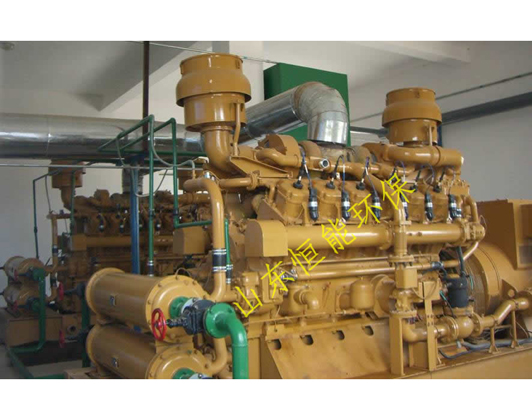沼氣作為一種可再生能源,通常沼氣是由甲烷和二氧化碳,另外還含有少量的硫化氫等氣體組成。硫化氫是一種劇毒的有害氣體,影響人體健康,空氣中含 0.1%的硫化氫可使人致命。而且對金屬管道、發(fā)電機沼氣鍋爐等用氣設(shè)備都有嚴(yán)重的腐蝕性,在燃燒的過程中產(chǎn)生的SO2也是一種腐蝕性很強的氣體 ,同時進(jìn)入大氣能產(chǎn)生“酸雨”,污染環(huán)境。
As a renewable energy source, biogas is usually composed of methane and carbon dioxide, as well as small amounts of gases such as hydrogen sulfide. Hydrogen sulfide is a highly toxic and harmful gas that affects human health. The presence of 0.1% hydrogen sulfide in the air can be fatal. Moreover, it has serious corrosiveness to gas equipment such as metal pipelines, generators, biogas boilers, etc. The SO2 generated during combustion is also a highly corrosive gas, and entering the atmosphere can produce "acid rain", polluting the environment.
我國環(huán)保標(biāo)準(zhǔn)嚴(yán)格規(guī)定:利用沼氣能源時,沼氣氣體中總硫含量不得超過20mg/m?。沼氣中的硫化氫質(zhì)量濃度一般為1~12g/m,遠(yuǎn)遠(yuǎn)高于我國環(huán)保標(biāo)準(zhǔn)的規(guī)定。因此,為保證人類健康和保護大氣環(huán)境 ,延長用氣設(shè)備等的使用壽命,沼氣在綜合利用之前必須進(jìn)行脫硫。
China's environmental protection standards strictly stipulate that when using biogas energy, the total sulfur content in biogas gas shall not exceed 20mg/m?. The mass concentration of hydrogen sulfide in biogas is generally 1-12g/m, which is far higher than the regulations of China's environmental protection standards. Therefore, in order to ensure human health, protect the atmospheric environment, and extend the service life of gas equipment, biogas must undergo desulfurization before comprehensive utilization.
沼氣脫硫一般可以分為干法脫硫、濕法脫硫和生物脫硫。
Biogas desulfurization can generally be divided into dry desulfurization, wet desulfurization, and biological desulfurization.

各種脫硫工藝簡介如下:
Introduction to various desulfurization processes is as follows:
干式脫硫:將干法脫硫劑填充在脫硫塔內(nèi),沼氣在進(jìn)氣和出氣過程中,通過與填料層內(nèi)的脫硫劑接觸,沼氣中硫化氫被吸收、吸附或發(fā)生其他反應(yīng),從而去除沼氣中硫化氫的過程稱為干法脫硫,它一般作為精細(xì)脫硫,適用于硫化氫含量低,氣體氣量小的情況。
Dry desulfurization: Fill the desulfurization tower with a dry desulfurization agent. During the intake and outlet processes of biogas, hydrogen sulfide in the biogas is absorbed, adsorbed, or undergoes other reactions by contacting the desulfurization agent in the filling layer, thus removing hydrogen sulfide from the biogas. This process is called dry desulfurization, which is generally used as fine desulfurization and is suitable for situations with low hydrogen sulfide content and small gas volume.
濕法脫硫:濕法脫硫是使沼氣中的硫化氫含有催化劑的液相中氧化成單質(zhì)硫的一種脫硫技術(shù)。該工藝分為兩個過程:吸收和再生。濕式化學(xué)法脫硫適用于硫化氫含量較高,氣體流量較大情況,但達(dá)不到干法脫硫的精度。
Wet desulfurization: Wet desulfurization is a desulfurization technology that oxidizes hydrogen sulfide in biogas into elemental sulfur in the liquid phase containing catalysts. The process is divided into two processes: absorption and regeneration. Wet chemical desulfurization is suitable for situations with high hydrogen sulfide content and high gas flow rate, but it cannot achieve the accuracy of dry desulfurization.
生物脫硫是一種新型的在歐洲、日本等國家和地區(qū)流行起來的沼氣脫硫技術(shù)。生物脫硫的原理類似于除臭,它依靠沾附在吸收塔填料表面上的硫桿菌屬和絲硫菌屬在新陳代謝的過程中吸收硫元素,進(jìn)而達(dá)到脫硫的目的。
Biological desulfurization is a new type of biogas desulfurization technology that has become popular in countries and regions such as Europe and Japan. The principle of biological desulfurization is similar to deodorization, which relies on the absorption of sulfur elements by Thiobacillus and Thiobacillus adhering to the surface of the absorption tower packing during metabolism, thereby achieving the goal of desulfurization.
